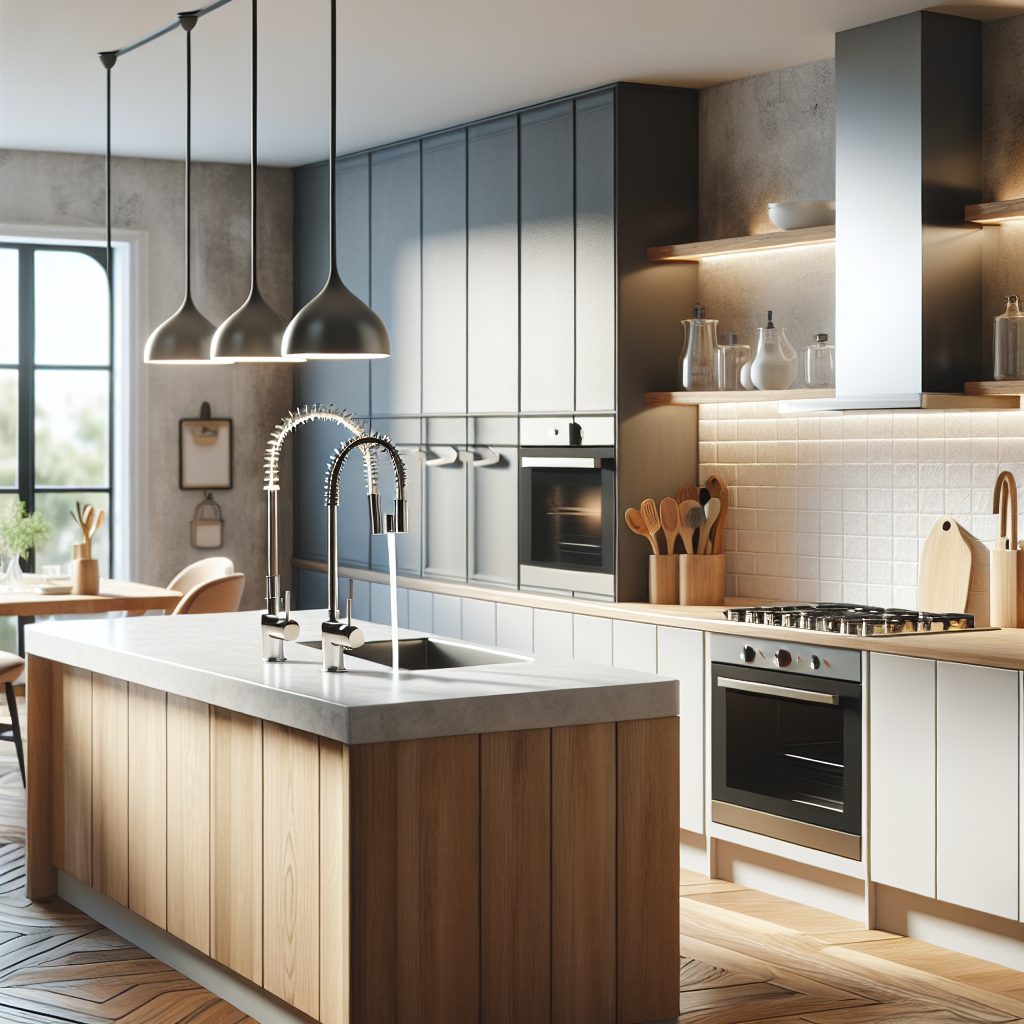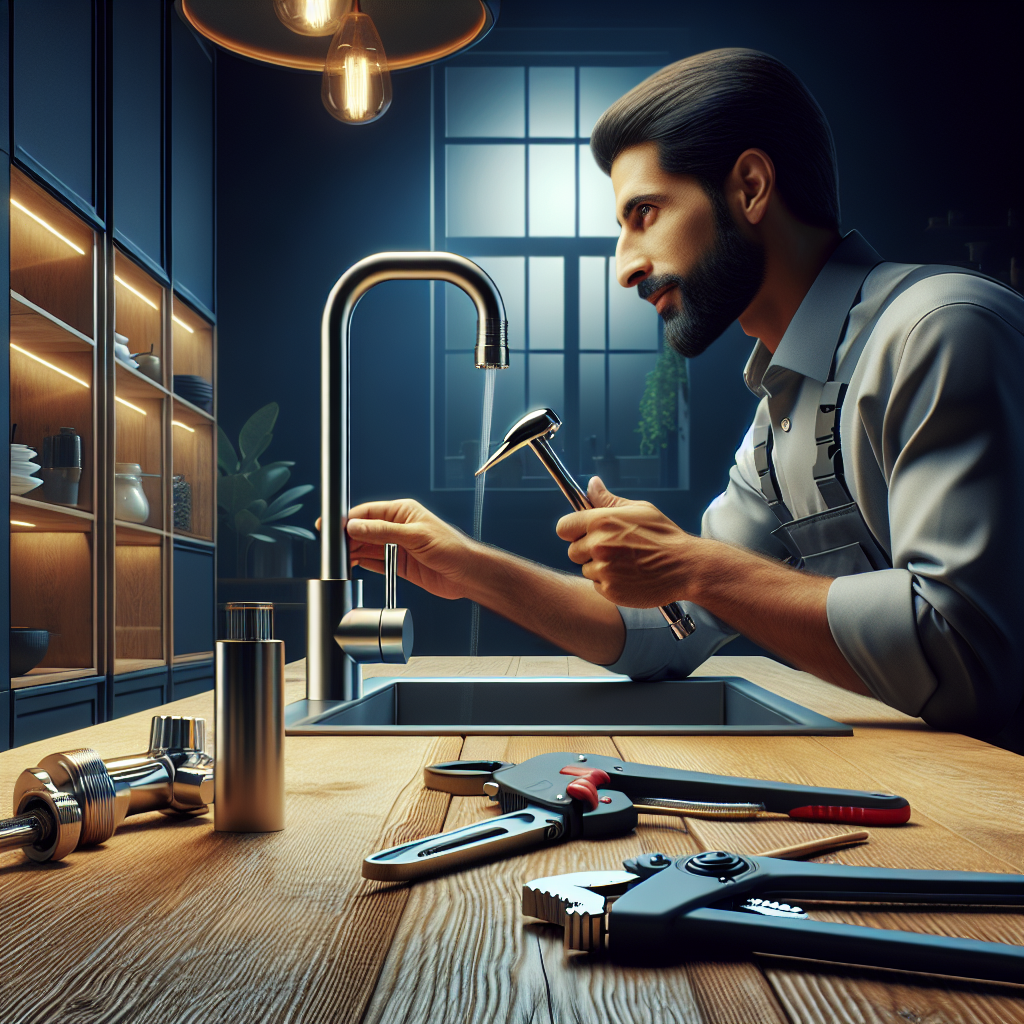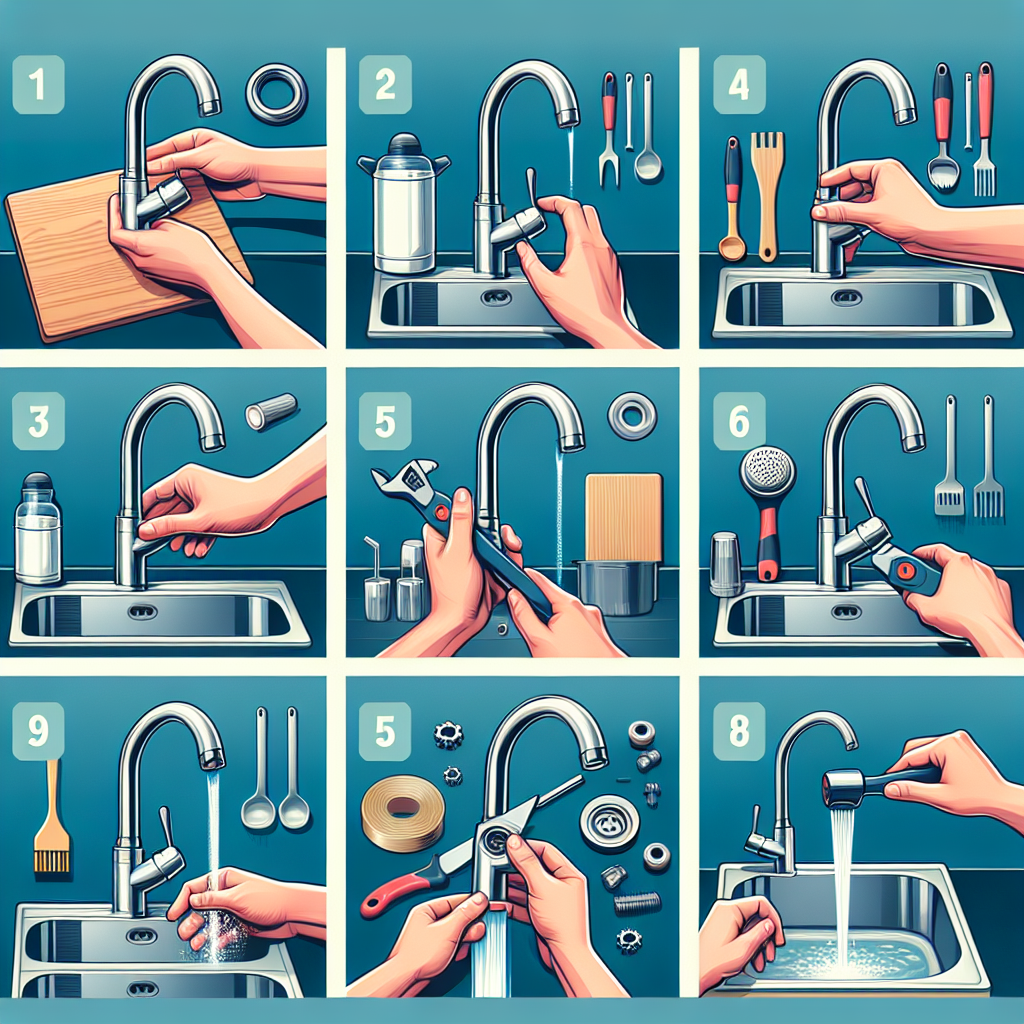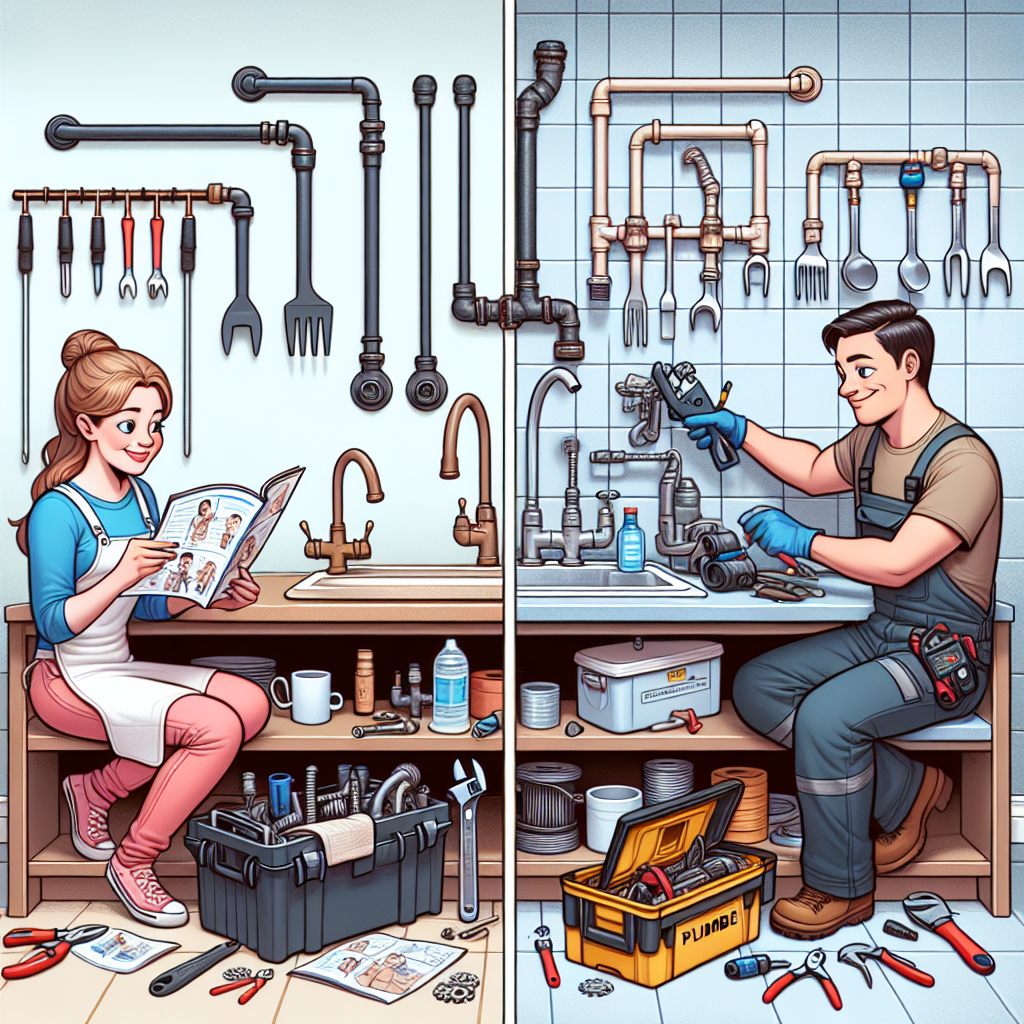DIY vs Professional Kitchen Faucet Replacement: What You Need to Know
Introduction
Welcome to the world of kitchen faucet replacement where the right choice can make or break your kitchen experience! Whether you’re dealing with a leaky faucet that’s more drippy than a sad love song or you’re simply ready to upgrade to one of those shiny, modern kitchen faucets that make your friends green with envy, this guide has you covered.
In this blog post, we’ll dive into the nitty-gritty of replacing your kitchen sink faucet. We’ll weigh the pros and cons of doing it yourself versus calling in the professionals. Spoiler alert: both options have their merits, and we’re here to help you figure out which one suits your needs best.
But before you grab your toolbox or pick up the phone, let’s explore some essential kitchen plumbing tips and common faucet issues that might just save you from a watery disaster. After all, no one wants to turn their DIY faucet replacement project into an episode of “This Old House Gone Wrong.”
Quick Tip: When choosing a new faucet, consider features like water efficiency and ease of installation. You’ll thank yourself later!

So roll up those sleeves, grab that wrench (or maybe just your phone), and let’s get into the details of how to replace that old faucet because your kitchen deserves better!
Understanding Kitchen Faucet Replacement
Ah, the kitchen faucet the unsung hero of our daily culinary adventures! When it comes to kitchen faucet replacement, we’re talking about more than just swapping out an old fixture; we’re diving into a world of choices, styles, and functionalities that can transform your kitchen sink experience.
What Exactly is Kitchen Faucet Replacement?
Simply put, kitchen faucet replacement is the process of removing your existing faucet and installing a new one. This can involve anything from a straightforward swap to a more complex installation that requires some plumbing finesse. Whether you’re dealing with a leaky faucet or just looking to upgrade to one of those fancy pull-out spray faucets, understanding what’s involved is key.
The Importance of Choosing the Right Faucet
Selecting the right kitchen sink faucet can make or break your kitchen experience. With options ranging from sleek high arc kitchen faucets to practical touchless kitchen faucets, it’s crucial to consider not just aesthetics but also functionality. A well-chosen faucet can enhance your cooking efficiency and even add value to your home.
Did You Know? A modern, water-efficient faucet can save you up to 30% on your water bill while helping you do your part for the environment! Talk about a win-win!
Common Misconceptions About Faucet Replacement
Many people think that replacing their old faucet is a job only for professional plumbers. While it’s true that some installations require expertise, many homeowners find that with the right tools and guidance, they can tackle this project themselves hello, DIY enthusiasts!
Kitchen Plumbing Tips for Success
- Always turn off the water supply before starting any plumbing project.
- Keep a bucket handy to catch any residual water when removing the old faucet.
- If you’re unsure about the installation process, consult a comprehensive guide or tutorial video.
- Don’t forget to check compatibility with existing plumbing not all faucets fit all sinks!
In conclusion, understanding the ins and outs of kitchen faucet replacement empowers you to make informed decisions whether you choose DIY or call in the pros. So roll up those sleeves or pick up that phone it’s time to give your kitchen sink the upgrade it deserves!
Common Reasons for Replacing a Kitchen Faucet
So, why would you want to dive into the world of kitchen faucet replacement? Let’s break it down like a well-structured recipe. Here are some common reasons that might have you reaching for those tools or calling in the pros:
- Leaky Faucets: If your kitchen sink faucet is dripping more than a leaky roof during a rainstorm, it’s time for a change. Not only is it annoying, but it can also lead to water waste and higher bills. Plus, nobody wants to deal with the dreaded “drip-drip-drip” soundtrack while trying to enjoy their morning coffee.
- Upgrading to Modern Fixtures: Maybe you’re tired of your outdated faucet looking like it belongs in a 90s sitcom. Upgrading to modern kitchen faucets can vastly improve the aesthetics of your space. Think sleek designs like high arc kitchen faucets or touchless kitchen faucets that scream “I’m fancy!”
- Water Efficiency Concerns: With an increasing focus on sustainability, many homeowners are opting for water-efficient faucets. These eco-friendly plumbing products not only help save the planet but also cut down on those pesky utility bills. It’s a win-win!
- Common Faucet Issues: If you’re constantly battling issues like low water pressure or an unreliable spray function, it might be time to consider replacing your faucet. No one wants to wrestle with their kitchen sink faucet just to fill up a pot.
- Aesthetic Refresh: Sometimes, you just want something new! Whether you’re going for brass kitchen faucets for that vintage vibe or chrome finish faucets for a modern look, changing out your faucet can be an easy way to refresh your entire kitchen.
Quick Tip: When replacing a leaky faucet, remember that sometimes all you need is a simple kitchen faucet repair like changing out the cartridge before deciding on a full replacement!

DIY Faucet Replacement: Pros and Cons
Thinking about rolling up your sleeves and diving into a DIY faucet replacement? You’re not alone! Many homeowners are tempted to swap out their old kitchen sink faucet for something shiny and new. But before you don your tool belt, let’s weigh the pros and cons of this home plumbing project.
Pros of DIY Faucet Replacement
- Cost Savings: Hiring a professional plumber can cost you a pretty penny. By tackling the job yourself, you can save on labor costs, putting that cash towards a luxury kitchen faucet instead!
- Satisfaction Guaranteed: There’s nothing quite like the thrill of completing a home project. It’s like leveling up in a video game you get to feel accomplished every time you turn on your new faucet.
- Control Over Your Project: You get to choose the exact style and features you want. Whether you’re after water-efficient faucets or high arc kitchen faucets, the choice is yours!
- Learning Experience: Each DIY project is an opportunity to learn something new about your home and plumbing systems. Plus, you’ll have some great stories for your next dinner party.
Cons of DIY Faucet Replacement
- Potential for Mistakes: If you’re not careful, you could end up with leaks or improperly installed fixtures. Imagine turning on your new faucet only to discover it’s spraying water everywhere not exactly the grand reveal you were hoping for!
- Lack of Tools or Experience: Not everyone has the right tools lying around for faucet installation. If you’re missing essential items like quick connect hoses or specific wrenches, it could complicate your project.
- Time-Consuming: DIY projects often take longer than expected. What starts as a simple swap can turn into an all-day affair if things don’t go as planned.
- Limited Warranty: Some manufacturers require professional installation for warranty coverage. So if something goes wrong down the line, you might be left holding the bag (and possibly paying out of pocket).
The bottom line? A DIY faucet replacement can be rewarding but comes with its own set of challenges. Weigh these pros and cons carefully before deciding whether to grab that wrench or call in the pros!
When to Hire a Professional Plumber
So, you’ve decided it’s time to replace your kitchen faucet, but now you’re standing at a crossroads: DIY or call in the pros? While the allure of a DIY faucet replacement can be tempting think of all that money saved there are moments when hiring a professional plumber is not just wise but necessary. Let’s dive into when it’s best to let the experts handle your kitchen plumbing woes.
Complexity of the Installation
If your new kitchen sink faucet is one of those fancy modern contraptions with all the bells and whistles like touchless technology or pull-out spray capabilities you might want to hit pause on your DIY ambitions. These high arc kitchen faucets can come with intricate installation requirements that could leave even the most seasoned DIYer scratching their head. If you find yourself tangled in quick connect hoses for sinks or unsure about how to change a faucet cartridge, it might be time to call in a professional.
Lack of Tools or Experience
Do you have tools lying around that haven’t seen daylight since last Thanksgiving? If you’re missing essential tools for faucet replacement, like basin wrenches or plumber’s tape, don’t fret! A professional plumber will come equipped with everything they need. Plus, if you’re not well-versed in home plumbing projects, attempting this task without experience could lead to more common faucet issues than you bargained for like leaks that could turn your kitchen into a mini swimming pool.
Time Constraints and Convenience Factors
Let’s face it: life is busy! Between work, family commitments, and binge-watching your favorite series, who has time for complex home repairs? Hiring a pro can save you precious hours (or even days) trying to figure out how to remove a leaky faucet or install those durable sink fixtures. Plus, professionals often complete jobs faster due to their expertise. So while you’re sipping coffee and watching cat videos, they’ll be busy transforming your kitchen!
Key Takeaway: If you’re facing complexity in installation, lack essential tools or experience, or simply value your time over potential DIY headaches, hiring a professional plumber is the way to go!

Tools and Materials Needed for DIY Faucet Replacement
Ready to dive into the world of kitchen faucet replacement? Before you start, let’s assemble your toolbox and gather the materials you’ll need. Think of it as your very own DIY starter pack, minus the superhero cape (but feel free to wear one if that helps!).
Essential Tools for Faucet Installation
- Adjustable Wrench: This is your best friend when it comes to tightening or loosening nuts and bolts.
- Screwdriver Set: A mix of flathead and Phillips screwdrivers will cover all your bases.
- Pliers: Perfect for gripping and twisting those stubborn fittings.
- Basin Wrench: Designed specifically for tight spaces under the sink, this tool is a must-have!
- Tape Measure: For ensuring that everything fits just right no one wants a faucet that’s too tall or short!
- Bucket or Towels: To catch any errant water when disconnecting your old faucet trust me, your floor will thank you.
Recommended Materials and Parts for Replacements
- New Faucet: Choose from a variety of styles like high arc kitchen faucets or low arc kitchen faucets based on your aesthetic preferences.
- Quick Connect Hoses: These make installation a breeze no more wrestling with awkward connections!
- Faucet Mounting Hardware: Usually included with your new faucet, but double-check to avoid last-minute runs to the store.
- Teflon Tape: Essential for sealing threaded connections to prevent leaks because nobody likes a leaky faucet!
- Kitchen Sink Plumber’s Putty: Great for creating watertight seals around drains and faucets.
The world of DIY faucet replacement can be both exciting and daunting. But with the right tools and materials in hand, you’ll be well on your way to successfully replacing that old kitchen sink faucet. So roll up those sleeves, put on some tunes, and let’s get started!
The Process of Replacing a Kitchen Faucet: Step-by-Step Guide (DIY)
Ready to dive into the world of kitchen faucet replacement? Whether you’re dealing with a leaky faucet or just want to upgrade to one of those snazzy modern kitchen faucets, this step-by-step guide will help you navigate the process like a pro.
Before you channel your inner DIY master, make sure you have the following tools handy:
- Adjustable wrench
- Plumber’s tape
- Bucket (to catch any sneaky water)
- Screwdriver (flathead and Phillips)
- Utility knife
Step 1: Turn Off the Water Supply
This is crucial! Locate the shut-off valves under your sink and twist them to turn off the water. If you don’t see them, be prepared to turn off your home’s main water supply. No one wants a surprise fountain in their kitchen!
Step 2: Remove the Old Faucet
First, place that trusty bucket under the sink to catch any leftover water. Next, disconnect the supply lines from the old faucet using your adjustable wrench. If they’re stubborn, a little elbow grease might be needed!
Now, unscrew any mounting nuts that hold the faucet in place. You may need to crawl under there and get cozy with some dust bunnies just part of the job!
Step 3: Prepare for Installation
If you’re replacing an old faucet, it’s smart to clean up any debris or old plumber’s putty from the sink surface. This ensures a good seal for your new fixture.
Step 4: Install Your New Kitchen Sink Faucet
This is where it gets exciting! Follow these steps:
- Position Your New Faucet: Place it in the mounting holes on your sink.
- Screw on Mounting Nuts: Secure it tightly but don’t overdo it you don’t want to crack anything!
- Connect Supply Lines: Attach those lines back onto your new faucet, ensuring they’re snug but not cross-threaded.
- Add Plumber’s Tape: Wrap plumber’s tape on threads for a leak-proof seal this is one of those key kitchen plumbing tips that can save you headaches later!
Step 5: Test for Leaks
Turn on your water supply and check for leaks by running both hot and cold water through your new faucet. If everything looks good, congratulations! You’ve successfully completed a DIY faucet replacement.

Your new kitchen sink faucet is not just an upgrade; it’s an opportunity to make your space more functional and stylish. Plus, you’ll have bragging rights at dinner parties about how you tackled this home plumbing project all on your own!
Selecting the Right Kitchen Faucet for Your Needs
Choosing the right kitchen faucet replacement is like selecting the perfect accessory for your outfit it’s not just about functionality; it’s about style, convenience, and making a statement!
Types of Kitchen Faucets
First things first, let’s break down the types of kitchen faucets. You generally have two main contenders:
- Single Handle Faucets: These are the cool kids on the block. They allow you to control both temperature and flow with one hand. Perfect for multitaskers!
- Double Handle Faucets: A bit more traditional, these faucets give you separate controls for hot and cold water. Ideal for those who like to keep things classic.
Aesthetics: Finishes and Styles
Your kitchen is your canvas, so why not paint it with style? The finish of your faucet can dramatically change the vibe of your space. Here are some popular options:
- Stainless Steel Faucets: Durable and modern, these beauties resist fingerprints and rust.
- Brass Kitchen Faucets: Offering a vintage touch, brass fixtures can add warmth to your kitchen.
- Chrome Finish Faucets: Sleek and shiny, chrome is perfect for a contemporary look but might require more polishing!
Features to Consider
Now that we’ve covered types and aesthetics, let’s talk features. Think of these as the bells and whistles that make life easier:
- Pull-Out Spray Faucets: These are great for rinsing vegetables or cleaning those hard-to-reach corners of your sink.
- Touchless Kitchen Faucets: Wave your hand to turn on the water perfect for when you’re elbow-deep in dough!
- High Arc vs Low Arc Kitchen Faucets: A high arc faucet offers more clearance for filling pots, while a low arc is more compact ideal for smaller kitchens.
Pro Tip: When selecting a faucet, consider its compatibility with existing plumbing. Not all faucets fit all sinks! Measure twice before you buy.
No matter what you choose, remember that a well-selected faucet can elevate your kitchen’s functionality while enhancing its aesthetic appeal. So take your time during this selection process it’s worth it!
Kitchens Upgrades: Beyond Just the Faucet Replacement
So, you’ve decided to replace your kitchen faucet. Congratulations! But before you pop the champagne (or at least the sparkling water), let’s talk about how you can take your kitchen from drab to fab with some complementary upgrades. Because, let’s face it, a shiny new faucet is like putting a bow on a gift; it’s great, but what’s inside matters too!
Complementary Kitchen Sink Upgrades
When considering kitchen sink upgrades, think of it as an ensemble cast rather than a solo act. Your kitchen sink is the stage, and your new faucet? It’s the star performer! Here are some upgrades that can elevate your entire kitchen:
- New Sink Material: Upgrade to a durable stainless steel or chic farmhouse sink. It’s not just about looks; quality materials can withstand the test of time and daily use.
- Deep Sinks: If you often find yourself battling with oversized pots and pans, consider a deeper sink for more room to maneuver.
- Integrated Accessories: Some sinks come with built-in cutting boards or colanders. Talk about multitasking!
Choosing Water-Efficient Faucets
If you’re on a mission to save both water and money (and who isn’t?), opt for water-efficient faucets. These modern marvels can reduce water usage without sacrificing performance. Here’s what to look for:
- Flow Rate: Look for faucets with a flow rate of 1.5 gallons per minute or less that’s less water down the drain and more savings in your pocket!
- Aerators: These little devices mix air into the water stream, reducing flow while maintaining pressure. It’s like giving your faucet a magic trick!
- Sleek Designs: Modern faucets come in various styles like touchless or pull-out spray models that not only conserve water but also add flair.
Quick Tip: Pairing your new faucet with an upgraded sink can create a cohesive look in your kitchen while enhancing functionality!
The world of kitchen plumbing is vast and exciting! By considering these upgrades alongside your faucet replacement, you’ll be well on your way to creating a space that’s not only beautiful but also highly functional.
- Complementary kitchen sink upgrades
< li >Choosing water-efficient faucets




Leave A Comment